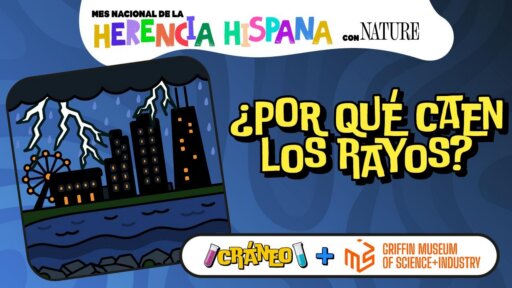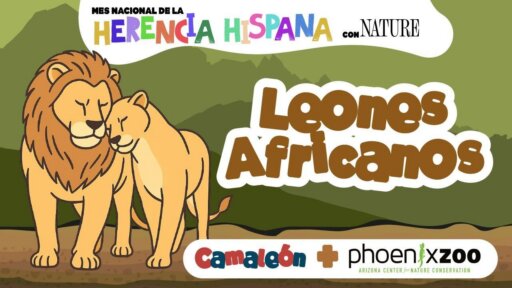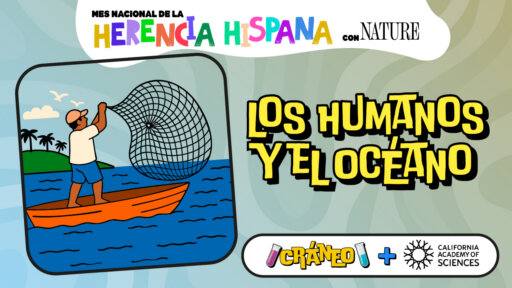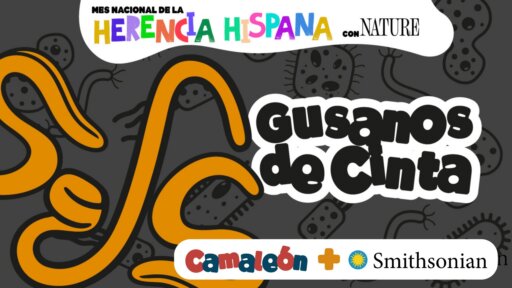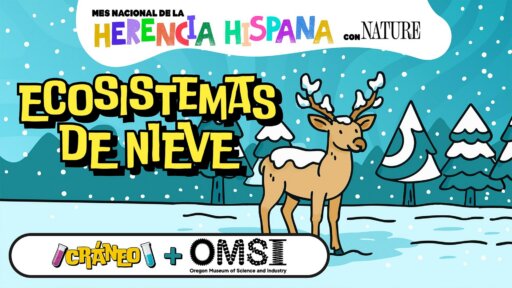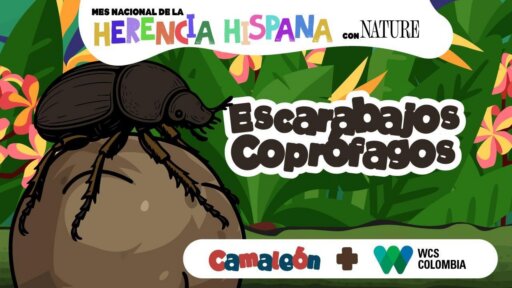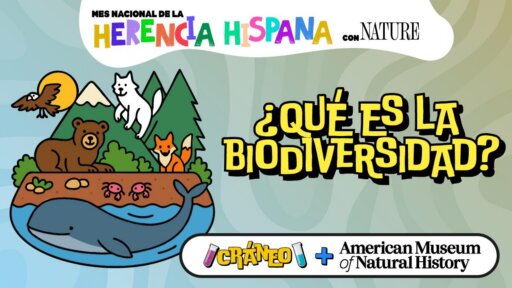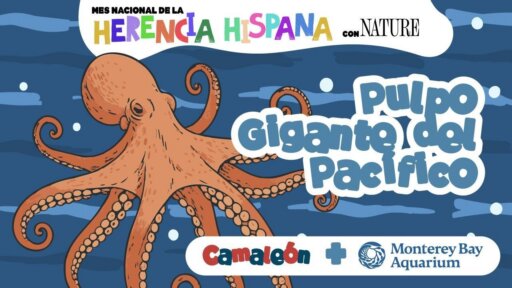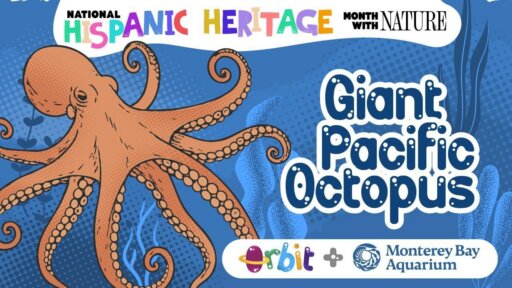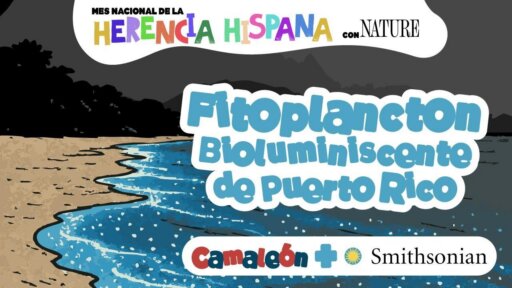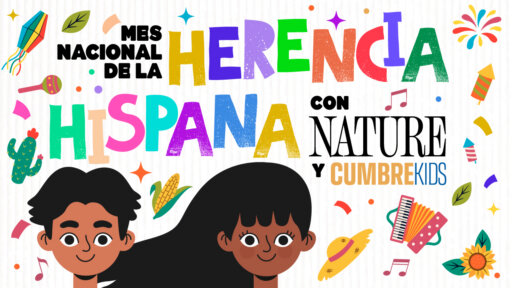TRANSCRIPT (EN)
00:00:01 Katherin:
Hello, parents, this episode is part of a special celebration for Hispanic Heritage Month.
00:00:07 Katherin:
We want to give a special thank you this month to the PBS Nature team, who have been collaborators in making this content possible.
00:00:18 Katherin:
And parents, we have also produced these episodes in English.
00:00:23 Katherin:
They are our very first episodes of the new podcast Orbit: Science for Kids on the Move.
00:00:30 Katherin:
We invite everyone to follow this podcast on your favorite platform to continue learning and having fun in English.
00:00:39 Katherin:
Alright, let’s begin the episode.
00:00:44 Katherin:
Hello Cráneos, hold on tight, today we’re not going to travel in spaceships.
00:00:49 Katherin:
No, no, no.
00:00:51 Katherin:
We’re going to jump straight into a giant swamp from 60 million years ago.
00:00:58 Katherin:
Ready?
00:00:59 Katherin:
Good.
00:01:08 Katherin:
Did you feel that?
00:01:10 Katherin:
Shhh, don’t move, because here, hidden in the mud, is the biggest snake that has ever existed in history.
00:01:20 Kids:
Hello Cráneos.
00:01:21 Kids:
And my question is: What was the Earth like when the Titanoboa lived?
00:01:27 Kids:
How long did the Titanoboa get?
00:01:30 Kids:
How do scientists know that the Titanoboa existed?
00:01:34 Kids:
Bye Cráneos, greetings.
00:01:37 Kids:
Bye.
00:01:38 Katherin:
Imagine a body as long as a school bus.
00:01:44 Katherin:
We need to know more about them.
00:01:47 Katherin:
There’s someone who can help us, a paleontologist who has seen its bones.
00:01:52 Katherin:
Come on, I’ll introduce you!
00:02:00 Dr. Carlos:
Hello, my name is Carlos Jaramillo and I am a paleontologist, which means someone who studies fossils to understand what life was like many, many years ago.
00:02:11 Dr. Carlos:
I work with the Smithsonian Institute in Panama City, in the country of Panama, in Central America.
00:02:18 Dr. Carlos:
Look at the map to see where it is, it’s a small strip that separates the Caribbean Sea from the Pacific Ocean.
00:02:24 Katherin:
That sounds amazing, doctor, I think what I saw was the biggest snake in history.
00:02:32 Vico:
Hi Carlos, my name is Vico.
00:02:34 Vico:
I live in Girardot, Colombia.
00:02:38 Vico:
My question is: What was the Titanoboa?
00:02:42 Fátima:
Hi, I’m Fátima, I live in Mexico, and my question is: How long was the Titanoboa?
00:02:49 Elena:
Hi Cráneos, my name is Elena, I’m 5 years old, and my question is: How long did the Titanoboa get? Thanks, bye.
00:03:04 Dr. Carlos:
The Titanoboa was a gigantic snake.
00:03:08 Dr. Carlos:
The largest that ever existed, it was about 14 meters long. Imagine that. It could have been up to 17 meters, but on average it was about 14. Fourteen meters is about 30 steps. When you have time, count 30 steps and you’ll see how long the Titanoboa was.
00:03:32 Dr. Carlos:
And it wasn’t only long, it was also wide, around a meter in diameter.
00:03:37 Dr. Carlos:
And that’s when it wasn’t eating. If it had eaten a turtle, for example, its body could increase by another meter, and it weighed around 1,000 kilos, which is about 100 bicycles.
00:03:52 Dr. Carlos:
It would be very hard to see, as most of the time it would be in the mud, near lakes and swamps, its body covered in algae and dull-colored.
00:04:06 Katherin:
Amazing.
00:04:07 Katherin:
That really was a huge size. Fourteen meters!
00:04:11 Katherin:
That’s like putting a snake along a school bus and still having a bit of tail left over. And to think it could reach 17 meters!
00:04:26 Katherin:
That makes me wonder about something.
00:04:29 Katherin:
I’ve heard that it could even be longer than a Tyrannosaurus Rex.
00:04:35 Katherin:
Could that be true?
00:04:39 Dr. Carlos:
Indeed, it was longer than a T-Rex.
00:04:42 Dr. Carlos:
On the Smithsonian Channel YouTube channel, you can find a battle between Titanoboa and T-Rex. Though remember, we don’t know if they lived at the same time, but if they had, the video shows how we imagine a battle between the two.
00:05:00 Dr. Carlos:
And of course, Titanoboa won.
00:05:04 Katherin:
I’ve already watched it, and it’s great, though it’s only an example of what could have been. It made me think of something.
00:05:13 Katherin:
If you had been there, would you have run as fast as you could or stayed to see who won?
00:05:22 Katherin:
What do you think if we talk about it with our family?
00:05:25 Katherin:
Who do you think would win if they really met?
00:05:28 Katherin:
Who would you root for?
00:05:29 Katherin:
The T-Rex or the Titanoboa?
00:05:32 Katherin:
Talk as a family about who you think would be the first to run away.
00:05:37 Katherin:
Would it be mom, dad, or you?
00:05:40 Katherin:
And if you could give yourself advice to survive, what would it be?
00:05:45 Katherin:
I think my advice would be to cover myself in mud and walk very slowly.
00:05:50 Katherin:
If you want, you can pause the episode to think about it, or you can do it at the end of the episode.
00:05:56 Katherin:
I’ll remind you later.
00:06:00 Katherin:
Ready?
00:06:01 Katherin:
Super!
00:06:04 Katherin:
And since we’re talking about things that make us imagine, let’s go to our mystery sound.
00:06:11 Katherin:
I’m going to let it play.
00:06:18 Katherin:
Listen again. Here are the options:
A) The sound of a shower
B) The sound of oil frying
00:06:38 Katherin:
Save your answer until the end. Now let’s go to more questions.
00:06:46 Elsa:
Hi, I’m Elsa and I’m from Argentina. My question is:
00:06:51 Elsa:
How have they counted the bones of the Titanoboa?
00:06:56 Alma:
Hi, I’m Alma, I’m five and a half years old, I live in Hoboken, New Jersey.
00:07:03 Alma:
And my question is: How do they know what the Titanoboa looked like?
00:07:08 Lorenzo:
Hi Cráneo, I’m Lorenzo Ávila, I’m seven years old.
00:07:13 Lorenzo:
I live in Margarita, Venezuela.
00:07:16 Lorenzo:
My question is…
00:07:18 Lorenzo:
How do scientists know the Titanoboa existed if we could never see it with our own eyes?
00:07:25 Lorenzo:
Bye Cráneo.
00:07:27 Katherin:
Great questions!
00:07:30 Dr. Carlos:
We haven’t seen the complete Titanoboa, but we’ve found many of its bones, and here’s a surprise—we didn’t just find one, but hundreds. It was one of the most common animals of that time.
00:07:47 Dr. Carlos:
When a Titanoboa died, all its muscles decomposed, and only its bones remained, and the Titanoboa had lots of them.
00:07:55 Dr. Carlos:
Imagine, more than 300 vertebrae, ribs, and all the skull bones.
00:08:02 Dr. Carlos:
Most of the time, we find one or two isolated vertebrae, but sometimes we’ve found up to 15 together.
00:08:10 Katherin:
That’s incredible!
00:08:12 Katherin:
I can’t imagine the work scientists must do to piece it together. It’s like trying to solve a puzzle without having seen the picture of what it should look like.
00:08:24 Katherin:
And speaking of that,
00:08:26 Katherin:
Do you want to know how they found the first pieces of this gigantic puzzle called Titanoboa?
00:08:35 Katherin:
Let’s travel back just a few years, around 2004, to a very hot place.
00:08:44 Katherin:
So let’s activate our time machine.
00:08:47 Katherin:
Ready to travel to the past and discover a story that changed science?
00:08:52 Katherin:
3, 2, 1… Traveling!
00:09:02 Dr. Carlos:
The first time we found Titanoboa was in a coal mine called Cerrejón, which is in Colombia.
00:09:10 Dr. Carlos:
This is the largest coal mine in the world and an amazing site for a paleontologist because many rocks are exposed,
00:09:20 Dr. Carlos:
so it’s easier to find fossils.
00:09:22 Katherin:
A team of scientists, including Dr. Carlos, went to work in one of the largest open-pit coal mines in the world, located in La Guajira, Colombia.
00:09:37 Katherin:
And on that first expedition…
00:09:41 Dr. Carlos:
We found many fossils of large animals, mainly crocodiles and turtles,
00:09:49 Dr. Carlos:
and we also found some very large vertebrae that didn’t look like a crocodile’s, so we packed them up.
00:09:57 Katherin:
They packed them up with a big question: What animal did these bones belong to?
00:10:04 Katherin:
What could it be?
00:10:06 Dr. Carlos:
Back at the lab, a student who was a snake fan was unpacking the fossils, and suddenly he uncovered one of these mysterious bones.
00:10:18 Dr. Carlos:
As soon as he saw it, he jumped and shouted: “This is a boa!” And of course, we immediately brought out a boa skeleton, and indeed, the vertebra was identical, except that Titanoboa’s was much, much bigger—a true giant.
00:10:37 Katherin:
With this image of the bone, they began to look at everything they had collected and—oh surprise!—there were many more.
00:10:47 Dr. Carlos:
The following year, we returned to Cerrejón and found hundreds of Titanoboas. It turned out to be one of the most common animals.
00:10:56 Katherin:
It was as if the mine had been Titanoboa’s favorite place to live or rest after eating millions of years ago.
00:11:07 Katherin:
And that brings us to another great question—or rather, several questions that our friends Martín, César, and Damika sent us.
00:11:17 Katherin:
Over to you, Cráneos.
00:11:22 César:
Hi Cráneos, I’m César Cantú, I’m five years old, I live in Nuevo León, Mexico.
00:11:30 César:
And my question is: What plants and animals lived with the Titanoboa?
00:11:37 César:
Bye, Cráneos, greetings.
00:11:40 Martín:
Hi Cráneos, I’m Martín, I’m seven years old, I live in Chile, and my question is: Did Titanoboa live with the dinosaurs, and if so, in which period did it live—the Triassic, Jurassic, or Cretaceous?
00:12:00 Martín:
Bye.
00:12:02 Damika:
Hi Cráneo, how are you?
00:12:03 Damika:
I hope you’re doing very well.
00:12:04 Kids:
My name is Damika, I’m eight years old, I live in Barquisimeto, Venezuela, and my question is: What was the Earth like when the Titanoboa lived?
00:12:14 Kids:
Thank you!
00:12:16 Dr. Carlos:
What interesting questions.
00:12:18 Dr. Carlos:
So far, we haven’t found Titanoboa from the time of the dinosaurs.
00:12:22 Dr. Carlos:
We found it precisely after they went extinct.
00:12:27 Dr. Carlos:
After the meteor hit Mexico and caused their extinction.
00:12:33 Dr. Carlos:
Titanoboa lived about 60 million years ago, in Colombia, in a tropical climate.
00:12:40 Dr. Carlos:
It was a very special time because it’s when the tropical rainforest we know today was first established.
00:12:47 Dr. Carlos:
That is, Titanoboa lived during the birth of the tropical rainforest as we know it today, but the climate was hotter,
00:12:57 Dr. Carlos:
about three degrees Celsius hotter, and not only hotter, but CO2, carbon dioxide, was higher than today.
00:13:06 Dr. Carlos:
And even though it was hotter, it was a forest with many trees and many large animals—not only Titanoboa but also several species of giant turtles and crocodiles,
00:13:20 Dr. Carlos:
some of which were completely land-dwelling and walked around the forest.
00:13:25 Dr. Carlos:
Also, in the water, there were gigantic fish several meters long that had lungs.
00:13:31 Dr. Carlos:
In short, it was truly a land of giants.
00:13:36 Katherin:
Exactly, Titanoboa lived in the Paleocene, right after the extinction of the dinosaurs. And although today the Cerrejón mine is in a very dry and hot part of Colombia, almost a desert, 60 million years ago, it was the exact opposite: a huge, humid tropical forest. Imagine a forest like the Amazon today,
00:14:06 Katherin:
with very tall trees, and those trees had flowers.
00:14:11 Katherin:
It rained a lot and was hotter than it is today.
00:14:16 Katherin:
And of course, our protagonist, the Titanoboa, was there, moving silently between the mud and the water.
00:14:26 Katherin:
Doctor, now I have a question.
00:14:28 Katherin:
How did Titanoboa develop its gigantic size and special body?
00:14:36 Dr. Carlos:
Reptiles, that is, snakes, crocodiles, and turtles, unlike us, do not regulate their internal temperature. They depend on the external temperature.
00:14:47 Dr. Carlos:
They are cold if the temperature is low and warm if the temperature is high.
00:14:53 Dr. Carlos:
And today, the longest snakes are found in the hottest places.
00:15:00 Dr. Carlos:
That’s why we believe one reason Titanoboa was so long is that the temperature was hotter than today.
00:15:09 Katherin:
So the heat from millions of years ago was like its secret ally.
00:15:14 Katherin:
If it lived in a super-hot place, its body could keep growing and growing.
00:15:21 Katherin:
It’s like the climate was a kind of charger giving it energy to become gigantic.
00:15:29 Joaquín:
Hi Cráneos, I’m Joaquín, I’m nine years old, I live in Mexico City, and my question is: What did Titanoboa eat?
00:15:41 Dr. Carlos:
Its favorite food was turtles.
00:15:44 Dr. Carlos:
At Cerrejón, we’ve found hundreds of fossil turtles, many of them giants over three meters long.
00:15:52 Dr. Carlos:
On some turtle shells, we’ve seen holes from Titanoboa attacks.
00:15:58 Dr. Carlos:
And in one case, we even found a Titanoboa tooth still embedded in a turtle’s shell.
00:16:05 Katherin:
Cráneos, you might be wondering now how Titanoboa could eat a giant turtle if turtles have such a hard shell.
00:16:16 Katherin:
Well, there’s a hypothesis. It’s likely this huge snake trapped the turtle with all its strength.
00:16:25 Katherin:
Titanoboa probably didn’t have venom, but its body was like a giant rope that could squeeze and squeeze until the turtle couldn’t move.
00:16:39 Katherin:
Then it would open its enormous mouth.
00:16:42 Katherin:
Its jaws were so flexible that it could swallow the entire turtle, shell and all.
00:16:50 Katherin:
Here’s the most amazing part.
00:16:53 Katherin:
It’s likely that its stomach acids were so strong they could dissolve bones and even the turtle’s shell.
00:17:03 Katherin:
So for Titanoboa, a turtle may have been like a crunchy lunch.
00:17:10 Oliver:
Hi, my name is Oliver, I’m five years old, we went to Santiago de Chile, and my question is: How many years ago did Titanoboa go extinct?
00:17:19 Oliver:
Or does it still exist?
00:17:22 Oliver:
Bye Cráneo!
00:17:23 Dr. Carlos:
We still don’t know when it went extinct.
00:17:26 Dr. Carlos:
We’ve found it in other places in Colombia, so we know it lived in many regions.
00:17:32 Dr. Carlos:
Why it went extinct is a mystery, but keep in mind
00:17:37 Dr. Carlos:
that all species eventually go extinct, just like an animal doesn’t live forever. The same happens to species; they don’t last forever.
00:17:47 Dr. Carlos:
While some go extinct, others are born, in a process we call evolution.
00:17:53 Dr. Carlos:
We don’t believe there’s such a big snake today, but if you ever see one, please tell me!
00:18:00 Katherin:
Yes, thank you, Dr. Carlos and Oliver.
00:18:04 Katherin:
Cráneos, can you imagine being the first to find the remains of a giant animal like Titanoboa?
00:18:11 Katherin:
Many scientists started as curious kids, just like you,
00:18:17 Katherin:
asking questions and dreaming of discovering incredible things.
00:18:21 Katherin:
Doctor, if someday our Cráneos want to look for fossils and learn about animals from the past, what kind of scientists do that?
00:18:31 Katherin:
And what things do our Cráneos need to learn to achieve it?
00:18:35 Dr. Carlos:
Scientists who study fossils are called paleontologists.
00:18:40 Dr. Carlos:
And there are several types of paleontologists.
00:18:43 Dr. Carlos:
Some study fossil leaves and trunks and are called paleobotanists. Others, like me, study fossil pollen grains and are called palynologists. Others study fossil bones, others study footprints and tracks left by living things, and others study the molecules that plants and animals had.
00:19:04 Dr. Carlos:
All this information allows us to understand what life was like in the past and how the climate and landscape
00:19:11 Dr. Carlos:
change over time.
00:19:13 Dr. Carlos:
To become a paleontologist, the most important thing is to be curious, observe nature, and ask questions about it, as well as read all kinds of books and have a great love for going into the field to find fossils.
00:19:31 Dr. Carlos:
Later, in college, you need to study geology—the study of the Earth and its rocks—and biology, the study of living things.
00:19:40 Katherin:
Wow, Cráneos.
00:19:42 Katherin:
Did you hear that?
00:19:44 Katherin:
Being paleontologists is like being detectives of the past.
00:19:48 Katherin:
They use clues like bones, footprints, and even tiny grains of pollen to discover what the Earth was like millions of years ago.
00:19:58 Katherin:
And the best thing is that any of you could do it someday
00:20:02 Katherin:
if you keep being curious, asking questions, and observing everything around you.
00:20:08 Katherin:
So the next time you see a strange rock or footprint, who knows?
00:20:14 Katherin:
You might be about to make your own discovery.
00:20:18 Dr. Carlos:
Cráneos, it was a great pleasure to be with you, and I hope one day you find a fossil as big as Titanoboa.
00:20:26 Katherin:
Thank you very much. We hope so too, doctor.
00:20:30 Katherin:
Let’s go to our mystery sound. I’m going to let it play. Listen one more time. Here are the options:
A) The sound of a shower
B) The sound of oil frying
00:20:59 Katherin:
It was a shower, very good!
00:21:04 Katherin:
Here’s a fun fact, just in case you didn’t know: astronauts don’t shower in space.
00:21:11 Katherin:
On the International Space Station, there are no showers. They use wet towels and no-rinse cleansers because water would float everywhere.
00:21:22 Katherin:
Do you know someone who would be happy just because of that detail?
00:21:27 Katherin:
Now, Cráneos, it’s time for special greetings.
00:21:31 Katherin:
Let’s start with Ethan, who’s celebrating his birthday.
00:21:35 Katherin:
He loves marine animals and learning about dinosaurs and listens to us from Saltillo, Mexico.
00:21:42 Katherin:
Happy birthday, Ethan.
00:21:44 Katherin:
We also greet Abel Luciano, in Mérida, Yucatán.
00:21:49 Katherin:
Hugs to Annie and Nolis, who listen to us from Virginia, USA.
00:21:56 Katherin:
Greetings to Luis Daniel and Fernanda in La Paz, Mexico.
00:22:00 Katherin:
Thank you very much.
00:22:01 Katherin:
Thank you, dear Cráneos, for listening and being part of this family. Hugs! And before we say goodbye, I want to remind you of the challenge: Did you talk with your family about who you think would win if the T-Rex and the Titanoboa met? Who would you root for? And remember, if you had to give yourselves advice to survive, what would it be?
00:22:28 Katherin:
Now yes, my dear Cráneos, we’ve reached the end of the episode.
00:22:32 Katherin:
Cráneo is a production of Cumbre Kids.
00:22:35 Katherin:
Robert Carpenter is the executive producer.
00:22:38 Katherin:
Moisés Monsalve, our graphic artist.
00:22:41 Katherin:
Jorge Cedillo, our illustrator.
00:22:43 Katherin:
And I’m Katherin Aguilar, producer of this podcast.
00:22:47 Katherin:
We’ll hear each other next week with a completely new episode.
00:22:53 Katherin:
Until then, keep your curiosity alive.

